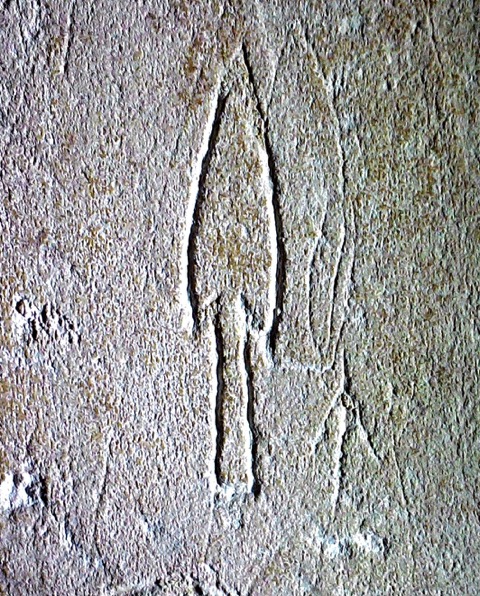- Screen Colours:
- Normal
- Black & Yellow

Medieval Graffiti with Andrew Macdonald
Departing from our normal focus on family and local history, our May meeting welcomed Andrew Macdonald to Kelsale Village Hall to deliver his excellent talk, fully titled ‘Staring at Walls – Graffiti in Religious and Secular Buildings from Medieval to Modern’.
Interested in history for most of his adult life, Andrew helped found the Waveney Valley Community Archaeology Group in 2013. Shortly afterwards, he began to explore medieval and post-medieval graffiti in religious and secular buildings. Nowadays, he and his wife spend much of their time seeking out and recording new examples of the musings of erstwhile ‘Banksies’, permanently etched in stone or wood in buildings across the country.
Interestingly, we first learned that, far from being regarded as anti-social, early forms of graffiti were fully accepted and often carved into the once bright walls of church interiors.
Andrew’s wide-ranging talk, accompanied by many impressive pictures, then took us on an enjoyable tour through the various categories of graffiti, which he broadly summarised as:
— Apotrapaic — intended to ward off evil spirits and consisting of various patterns, including hexfoils, peltas and the more widely recognised Star of David and pentangles;
— Devotional — typically taking the form of a simple cross;
— Signalling troubled times — often reflecting the date of tumultuous events, such as the Great Plague of 1666 or the Glorious Revolution of 1688;
— Memorial — by which individuals recorded their initials or, in some cases, full names, for posterity, reminding future generations that ‘I was here’;
— Secular — covering a wide range of images, including armorial bearings, marks left by masons or merchants to witness their presence and other ‘doodles’ captured in images of ships, animals, human figures and musical instruments, to name but a few.
Throughout his presentation, Andrew was at pains to stress that many aspects of the subject and the meaning of the graffiti is very much open to conjecture. This is because, as a relatively new area of focus for academics, research is handicapped by the lack of comparable material and established research guidelines. Indeed, in one major text to which Andrew’s contribution is acknowledged, the author Matt Champion, writes ‘The little already written on the subject tends to consist largely of site-specific studies of a single church, which do little to help understand the larger themes and bigger picture. A quick read of the published literature soon makes you feel as if you are using a magnifying glass to examine an elephant’.
A lively question and answer session proved to be a testament to Andrew’s infectious enthusiasm for his subject matter, as well as the broad knowledge he has acquired in a relatively short time.
For those wishing to know more about this fascinating subject, Matt Champion’s book, ‘Medieval Graffiti – The Lost Voices of England’s Churches’, published by Ebury Press, is widely available. There is also plentiful online material, including the excellent website of the Norfolk Medieval Graffiti Survey (URL: http://www.medieval-graffiti.co.uk/page40.html) where some of the images used in Andrew’s presentation can be found.
No doubt, all of those in attendance will be keeping an eye out for graffiti when they next visit a church, even if they don’t feel moved to scratching their own memorial on a chancel pillar or the back of a pew!
Chris Broom
 |
 |
 |
 |